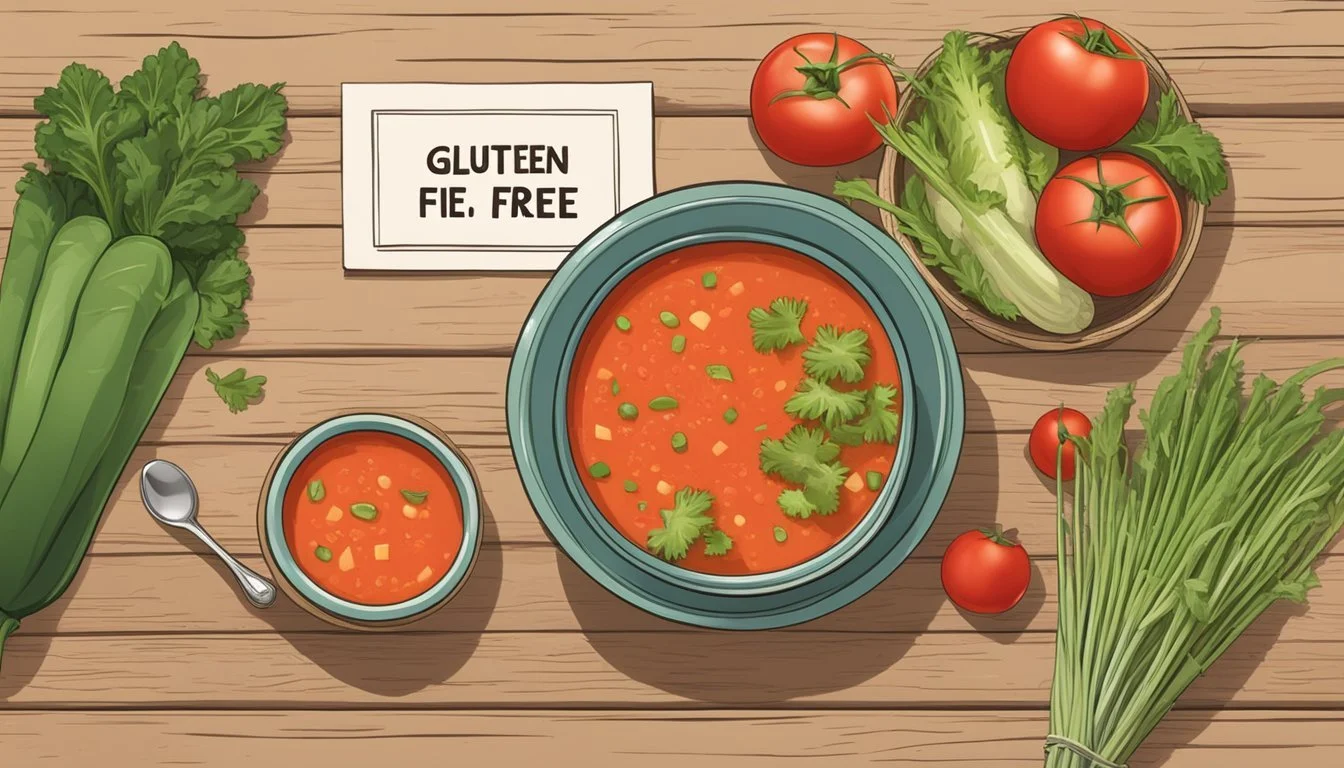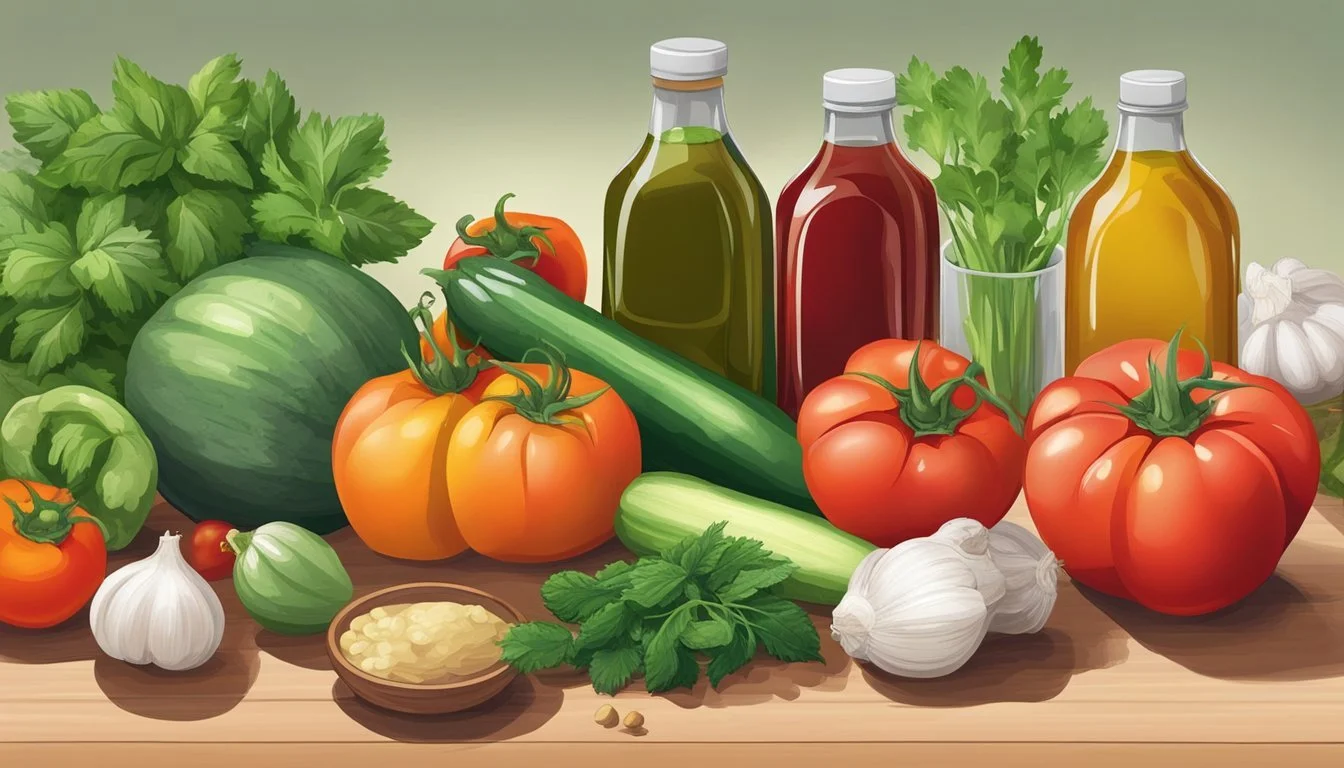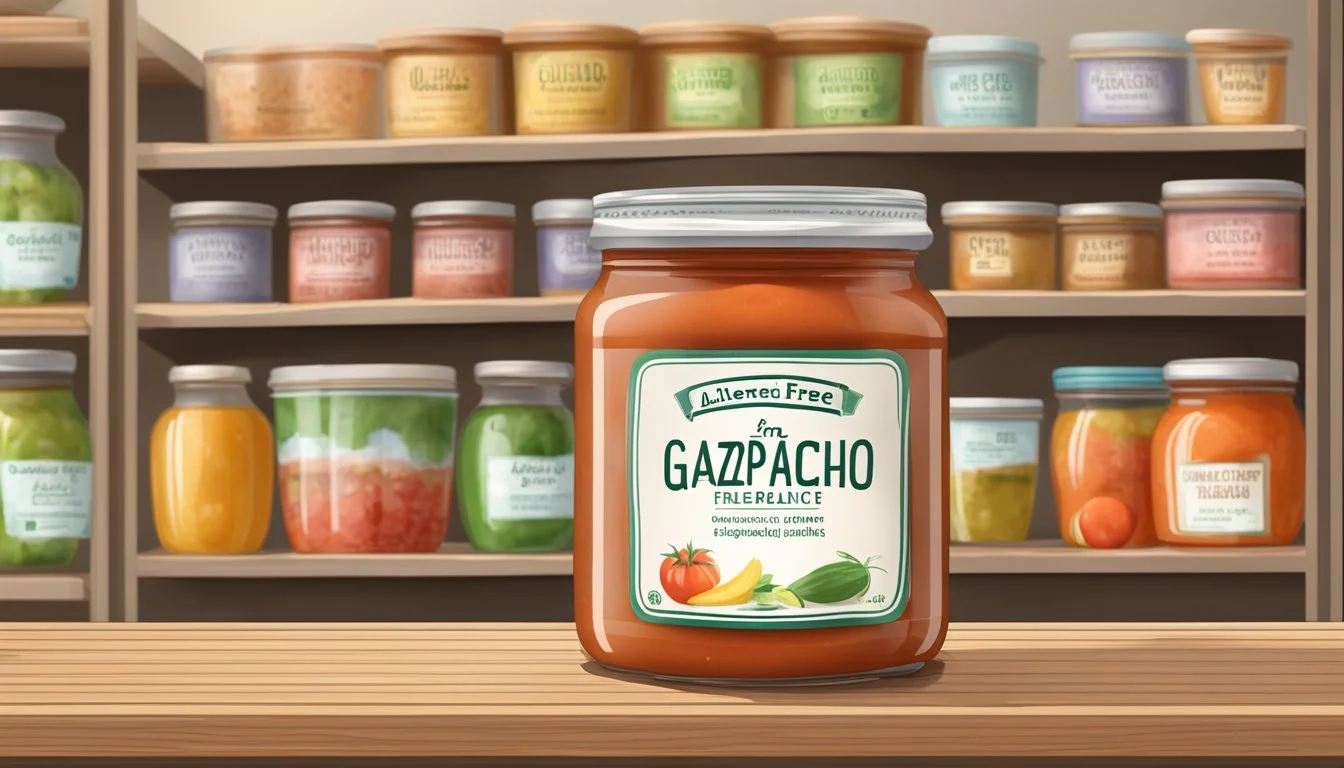Is Gazpacho Gluten-Free?
Unveiling the Truth About This Chilled Soup
Gazpacho, a traditional Spanish soup known for its refreshing qualities, is a popular choice during the summer months. It is a cold soup that combines ripe tomatoes, cucumbers, bell peppers (What wine goes well with bell peppers?), onions, (What wine goes well with onions?) and a variety of seasonings. This blend of vegetables offers a light and refreshing meal or appetizer that is often served chilled, making it an ideal dish for hot weather.
When it comes to dietary restrictions, particularly for those who are gluten-intolerant or have celiac disease, the question of whether gazpacho is gluten-free is quite pertinent. Most classic gazpacho recipes call for ingredients that are naturally free of gluten, such as fresh vegetables and olive oil. However, some variations might include bread as a thickener, which traditionally contains gluten unless specified otherwise.
Individuals seeking gluten-free options can be assured that gazpacho can be made gluten-free with the right ingredients. For those preparing gazpacho at home, ensuring that all components, such as bread or store-bought tomato juice, are labeled gluten-free is essential. Similarly, when dining out, it is advisable to confirm with the chef that the gazpacho served does not contain any gluten-containing ingredients. This due diligence allows everyone, regardless of dietary restrictions, to enjoy the cool delight of gazpacho without concern.
What is Gazpacho?
Gazpacho is a traditional Spanish soup known for its refreshingly cold serving temperature. Originating from the southern region of Andalusia, gazpacho is part of a family of cold soups (What wine goes well with soups?) that are quite popular, especially during the hot summer months.
This raw soup is typically made from a blend of vegetables and served chilled. Its base ingredients often include:
Tomatoes
Cucumbers
Bell peppers
Garlic
These ingredients are combined into a puree and seasoned with ingredients like olive oil, vinegar, and salt. Gazpacho can be garnished with additional chopped vegetables, croutons, or a drizzle of olive oil, depending on the chef's preference.
The beauty of gazpacho lies in its simplicity and versatility. As it is a dish that is not cooked, it retains the raw flavors and nutrients of the vegetables. The exact recipe for gazpacho can vary widely, with each household or chef adding their own twist to the classic formulation.
In summary, gazpacho provides a cool respite from the heat and offers a flavorful experience with its blend of raw vegetables and zesty seasonings. It stands as a hallmark of Spanish cuisine and continues to be enjoyed for its taste and ease of preparation.
Assessing Gluten in Gazpacho Ingredients
Gazpacho is a refreshing soup often enjoyed during the warmer months, but for individuals with gluten sensitivities, understanding the gluten content in gazpacho ingredients is vital. This section will examine the typical ingredients used in gazpacho to determine their gluten status.
Common Ingredients and Gluten Content
Tomatoes, cucumbers, peppers, onions, and garlic: These fresh vegetables are naturally gluten-free and form the base of most gazpacho recipes. Gluten is a protein found in wheat, barley, and rye, and does not naturally occur in these vegetables.
Olive oil and vinegar: Olive oil is a gluten-free fat, and most vinegars are gluten-free as well. However, vinegars derived from gluten-containing grains should be verified as being distilled, which makes them gluten-free.
Salt: Salt is a mineral that is inherently gluten-free and safe for those with gluten sensitivities.
Understanding Gluten-Free Recipes
When a gazpacho recipe is labeled as gluten-free, it suggests that the recipe either does not include any gluten-containing ingredients or uses gluten-free alternatives. Individuals should always read labels and be aware of cross-contamination risks when purchasing store-bought ingredients for gazpacho.
Gluten Presence in Bread and Alternatives
Bread: Traditional gazpacho recipes may include bread as a thickener, which typically contains gluten unless specifically made with gluten-free flour.
No Bread Alternatives: For a guaranteed gluten-free gazpacho, one should either omit bread entirely or use gluten-free bread or bread alternatives. This adaptation ensures the gazpacho remains thickened without introducing gluten into the recipe.
Choosing the Right Ingredients
When creating gluten-free gazpacho, quality and freshness of produce ensure maximum flavor and nutritional value. The choice of oil and vinegar, as well as the selection of herbs and spices, deeply influences the final taste of the dish.
Selecting Fresh Vegetables
For the best gazpacho, one should use ripe tomatoes as the base, providing both body and sweetness. English cucumbers are favored for their fewer seeds and crisp texture. Bell peppers add a subtle sweetness and crunch, and red onions lend a sharp depth. To round off the vegetable base, garlic cloves are essential for their piquant flavor.
The Role of Olive Oil and Vinegar
Extra-virgin olive oil imparts a rich, fruity undertone that is quintessential in gazpacho. Its quality can make a significant difference, so one should opt for a high-grade, flavor-dense oil. Similarly, sherry vinegar or red wine vinegar provides a bright acidity that balances the sweetness of the vegetables. When seasoned with sea salt and black pepper, these liquids emulsify with the vegetable puree to create a harmonious blend.
Herbs and Spices for Flavor Enhancement
Herbs like fresh basil, cilantro, and parsley infuse gazpacho with aromatic freshness and should be used judiciously to complement the primary flavors rather than overpower them. Spices such as cumin and smoked paprika can add a layer of complexity and a hint of warmth, elevating the gazpacho to a nuanced culinary experience.
Preparing Gazpacho
Gazpacho preparation involves a few crucial steps, from combining fresh ingredients to achieving the perfect consistency and chill. Following these procedures ensures a delicious and refreshing gluten-free soup.
Essential Preparation Steps
Ingredients: Start with quality, ripe vegetables like tomatoes, cucumbers, and bell peppers. Essential ingredients include:
3 lbs ripe tomatoes
1 English cucumber
1 bell pepper
Red onion and garlic to taste
Jalapeño (optional for heat)
Salt for seasoning
Prep Time: Begin by coarsely chopping vegetables. Toss them with salt to extract moisture and enhance flavors. The mixture should rest for about 45 minutes before blending.
Blending Techniques for the Ideal Texture
To achieve a smooth and creamy consistency, a high-powered blender or food processor is optimal. Pulse the prepared vegetables until they reach the desired texture, which can range from slightly chunky to smooth. If the soup is too thick, adding tomato juice can help thin it out.
Chilling Methods for Optimal Refreshment
Chill Time: Gazpacho's refreshment quality improves when it's well-chilled. Transfer the blended soup to a container and refrigerate it. For best results, chill for at least 2 hours; ideally, 8 hours or overnight to allow flavors to meld.
The chilling process is critical; it not only cools the soup but also gives the flavors time to develop and meld together, creating a more harmonious and refreshing taste experience. Utilizing these methods, one ensures the gazpacho is served at an optimal temperature and texture.
Serving and Garnishing Gazpacho
As a chilled soup, gazpacho offers a refreshing option for an appetizer or light lunch, and its appeal is heightened by thoughtful garnishes and presentation that suits its vibrant colors and textures.
Appropriate Gazpacho Garnishes
When garnishing gazpacho, the aim is to enhance both its flavor and visual appeal. Fresh veggies like diced cucumber, bell peppers, and cherry tomatoes add crunch and vibrancy. For a creamy element, consider small cubes of avocado that complement the acidity of the tomato-based soup. Traditional garnishes also include finely chopped hard-boiled eggs and croutons. Here is a list of suitable gazpacho garnishes:
Sliced cherry tomatoes
Finely chopped bell peppers
Cubed avocado
Chopped hard-boiled eggs
Gluten-free croutons
Creative Serving Ideas
Gazpacho is versatile in its serving options. It can be presented in clear bowls or cups to showcase its color, making it ready for a photo perfect for sharing on Instagram. Some hosts may opt for serving gazpacho in shot glasses for a unique appetizer at gatherings. To elevate the experience, place a garnish on the rim of the serving dish or float it elegantly on top. Below are creative ideas for serving your gazpacho:
Clear Bowls: Display the soup's color and garnishes.
Shot Glasses: Offer as a mini-appetizer for events.
Rim Garnishes: Place a small skewer of cherry tomatoes or cucumber slices on the dish's rim.
Floating Garnish: A sprig of fresh herbs or avocado slice can be floated on top for an elegant finish.
Nutritional Profile of Gazpacho
Gazpacho, commonly known for its refreshing and light qualities, stands out as a nutrient-dense option that provides calories, fiber, and a wealth of vitamins and minerals while primarily consisting of fresh vegetables.
Calorie and Macronutrient Breakdown
Gazpacho generally carries a low calorie count due to its primarily vegetable-based ingredients. A typical serving can range between 100-150 calories, making it an excellent choice for individuals monitoring their caloric intake. The macronutrient composition of gazpacho showcases:
Proteins: Minimal content, as vegetables are not high in protein.
Fats: Low to moderate, primarily coming from the olive oil, which provides healthy monounsaturated fats.
Carbohydrates: Predominately from vegetable sugars and fiber, presenting a balanced energy source.
Gazpacho's Fiber Content
The fiber profile of gazpacho is appreciable, as it primarily relies on raw vegetables which are naturally high in dietary fiber. This soup can contribute to an individual's daily fiber requirements, aiding digestion and supporting cardiovascular health. On average, a bowl of gazpacho might provide between 2 to 5 grams of dietary fiber, depending on the amount and types of vegetables used.
Vitamins and Minerals in Gazpacho
Rich in micronutrients, gazpacho can be a significant source of vitamins and minerals, essential for various bodily functions. Commonly featured vegetables such as tomatoes, cucumbers, and bell peppers are loaded with vitamin C, potassium, and a variety of antioxidants. If organic ingredients are used, the nutritional profile might be perceived as more favorable due to the preference of some consumers for organic produce. Here are some specifics:
Vitamin A & Lycopene: Tomatoes offer vitamin A and lycopene, both known for their roles in eye health and as antioxidants.
Vitamin K: Cucumbers contain vitamin K, which is important for blood clotting and bone health.
Vitamin E: Olive oil provides vitamin E, a fat-soluble antioxidant that protects cells from damage.
Minerals: Magnesium and iron, present in leafy greens that might be added to gazpacho, are imperative for muscle function and oxygen transport, respectively.
In conclusion, gazpacho offers a diverse range of nutrients in a refreshingly light package, making it a valued dish for health-conscious individuals.
Customizing Your Gazpacho
Creating the perfect Gazpacho is about understanding the balance of flavors and respecting dietary preferences. This section explores the customization of Gazpacho to be gluten-free and vegan, adjusting the sweetness and acidity, and experimenting with different vegetables.
Gluten-Free and Vegan Variations
Gazpacho can be easily adapted to suit both gluten-free and vegan diets without compromising on taste. Traditional Gazpacho is naturally gluten-free as it primarily consists of vegetables like tomatoes, cucumbers, and peppers. To ensure it's gluten-free, one should avoid using bread as a thickener or confirm the bread used is certified gluten-free. For a vegan version, ensuring that no animal-derived garnishes or stocks are added is key. A variety of gluten-free alternatives for texture, such as soaked and blended raw, unsalted cashews, can be used.
Adjusting Sweetness and Acidity
The balance of sweetness and acidity is crucial in Gazpacho. For those preferring a sweeter taste, Vidalia onions can be a great addition due to their mild, sweet flavor profile. To adjust acidity, the type of vinegar used plays a significant role; apple cider vinegar lends a subtle fruity tang while red wine vinegar provides a sharper note. The amount of each can be altered based on personal preference.
For a sweeter Gazpacho:
Use sweeter vegetables like Vidalia onions or ripe Roma tomatoes.
To increase acidity:
Add more red wine vinegar or apple cider vinegar, tasting as you go.
Experimenting With Different Vegetables
One can get creative by adding or substituting different vegetables in Gazpacho. A switch from the traditional bell peppers to an Anaheim pepper can introduce a different level of spiciness and complexity. For a chunkier texture, consider less traditional options like diced avocado or minced celery. The key is to select fresh, high-quality vegetables for the best outcome.
Vegetable variations to try:
Add diced Anaheim peppers for a hint of heat.
Incorporate other fresh vegetables like celery or avocado for texture.
Storing and Preserving Gazpacho
Proper storage is essential to maintain the freshness and flavor of gazpacho. Here's how to ensure that this chilled soup stays at its best.
Best Practices for Gazpacho Storage
Temperature: Gazpacho should be kept refrigerated at all times. The optimal storage temperature is below 40°F (4°C).
Containment: Use an airtight container to store gazpacho to prevent the absorption of other flavors from the refrigerator and to keep it fresh.
Duration: For best quality, consume gazpacho within 2-3 days of preparation.
Yield Management: Promptly refrigerate any leftovers to minimize the risk of bacterial growth.
Freezing and Thawing Gazpacho
Freezing
Preparation: Gazpacho can be frozen for up to 2 months. Peace of mind comes from having a ready-to-use meal for later.
Container: Use either heavy-duty freezer bags or airtight freezer containers.
Portioning: Freeze in portion-sized batches for ease of thawing.
Thawing
Defrosting: Thaw overnight in the refrigerator for optimal texture.
Consistency Check: After thawing, stir the gazpacho well as separation may occur during freezing.
Serving Suggestion: Add a fresh garnish to revitalize flavors after thawing.
Advanced Gazpacho Tips
Enhancing the depth of gazpacho involves a meticulous balance of flavors and textures. These advanced tips will guide home cooks in refining their gazpacho to achieve a harmonious blend and a luxurious mouthfeel.
Balancing Flavor With Garnishes
Gazpacho, at its heart, is a vibrant tomato soup. To elevate it, one must understand the impact of garnishes on the overall flavor profile. Shallots bring a subtle sharpness which complements the acidity of tomatoes. For a touch of sweetness, consider drizzling a little honey over the top before serving. This not only contrasts the tanginess of the tomato juice but also rounds out the flavors.
Garnishes to Consider:
Shallots: Finely diced for a sharp, yet not overpowering, bite.
Honey: A drizzle to balance the tartness of the tomatoes.
Achieving Consistency in Texture
The texture of gazpacho can vary from smooth to chunky. For those preferring a smooth consistency, it's important to properly blend the base ingredients like tomato juice, red peppers, and tomato seeds, achieving a silky puree. If a chunkier, more robust texture is desired, one should meticulously dice ingredients like red bell peppers and ensure they are consistent in size for uniformity in every spoonful.
Texture Techniques:
Smooth: Blend until a pureed consistency is reached; strain to remove any remaining solids.
Chunky: Combine finely diced vegetables with the liquid base, reserving some for topping.








